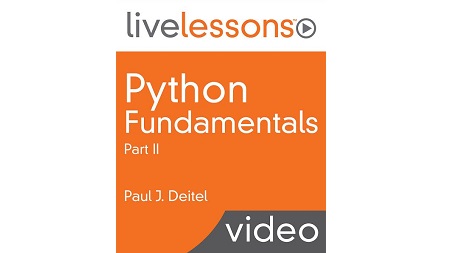
English | MP4 | AVC 1280×720 | AAC 44KHz 2ch | 9h 02m | 3.04 GB
The professional programmer’s Deitel® video guide to Python development with the powerful IPython and Jupyter Notebooks platforms.
Python Fundamentals LiveLessons with Paul Deitel is a code-oriented presentation of Python–one of the world’s most popular and fastest growing languages. In the context of scores of real-world code examples ranging from individual snippets to complete scripts, Paul will demonstrate coding with the interactive IPython interpreter and Jupyter Notebooks. You’ll quickly become familiar with the Python language, its popular programming idioms, key Python Standard Library modules and several popular open-source libraries. In the Intro to Data Science videos, Paul lays the groundwork for later lessons in which he’ll introduce some of today’s most compelling, leading-edge computing technologies, including natural language processing, data mining Twitter® for sentiment analysis, cognitive computing with IBM® Watson™, supervised machine learning with classification and regression, unsupervised machine learning with clustering, computer vision through deep learning and convolutional neural networks, sentiment analysis through deep learning with recurrent neural networks, big data with Hadoop®, Spark™ streaming, NoSQL databases and the Internet of Things.
What you will learn in Part II:
- Lesson 5—Sequences: Lists and Tuples—Create, initialize and access the elements of lists and tuples; sort and search lists, and search tuples; pass lists and tuples to functions and methods; list methods; functional-style programming (lambdas, filter, map, reduce, list comprehensions, generator expressions, 2D lists); static visualization with the Seaborn and Matplotlib visualization libraries.
- Lesson 6—Dictionaries and Sets—Dictionaries of key–value pairs; sets of unique values; iterating through keys, values and key–value pairs; adding, removing and updating key–value pairs; dictionary and set comparison operators; set operators and methods; operators in and not in for membership testing; mutable set operations; dictionary and set comprehensions; dynamic visualization with the Seaborn and Matplotlib visualization libraries.
- Lesson 7—Array-Oriented Programming with NumPy—numpy module’s high-performance ndarrays; how ndarrays differ from lists; comparing list vs. ndarrayperformance with the IPython %timeit magic; one-dimensional and multidimensionalndarrays; common ndarray manipulations; introduction to the pandas data manipulation library; one-dimensional Series and two-dimensional DataFrames; custom Series and DataFrame indices; basic descriptive statistics for data in aSeries and a DataFrame; customizing pandas output formatting.
Table of Contents
1 Introduction to Python Fundamentals – Part 2
2 Lesson overview
3 Lists
4 Self Check
5 Tuples
6 Self Check
7 Unpacking Sequences
8 Creating a primitive bar chart
9 Self Check
10 Sequence Slicing Part 1 – Getting a Subset of a Sequence
11 Sequence Slicing Part 2 – Modifying a List
12 Self Check
13 del Statement
14 Self Check
15 Passing Lists to Functions
16 Sorting Lists
17 Self Check
18 Searching Sequences
19 Self Check
20 Other List Methods
21 Self Check
22 Simulating Stacks with Lists
23 List Comprehensions
24 Self Check
25 Generator Expressions
26 Self Check
27 Filter, Map and Reduce
28 Self Check
29 Other Sequence Processing Functions
30 Self Check
31 Two-Dimensional Lists
32 Self Check
33 Intro to Data Science – Simulation and Static Visualizations
34 Sample Graphs for 600, 60,000 and 6,000,000 Die Rolls
35 Visualizing Die-Roll Frequencies and Percentages–Part 1
36 Visualizing Die-Roll Frequencies and Percentages–Part 2
37 Visualizing Die-Roll Frequencies and Percentages–Part 3
38 Visualizing Die-Roll Frequencies and Percentages–Part 4
39 Lesson overview
40 Dictionaries
41 Creating a Dictionary
42 Self Check
43 Iterating through a Dictionary
44 Basic Dictionary Operarations
45 Self Check
46 Dictionary Methods keys and values
47 Self Check
48 Dictionary Comparisons
49 Example – Dictionary of Student Grades
50 Example – Word Counts
51 Python Standard Library Module collections
52 Self Check
53 Dictionary Method update
54 Dictionary Comprehensions
55 Self Check
56 Sets
57 Self Check
58 Comparing Sets
59 Self Check
60 Mathematical Set Operations
61 Self Check
62 Mutable Set Operators and Methods
63 Set Comprehensions
64 Intro to Data Science – Dynamic Visualizations–How Dynamic Visualization Works
65 Intro to Data Science – Dynamic Visualizations–Implementing Dynamic Visualization, Part 1
66 Lesson overview
67 Creating arrays from Existing Data
68 Self Check
69 array Attributes
70 Self Check
71 Filling arrays with Specific Values
72 Creating arrays from Ranges
73 Self Check
74 List vs. array Performance – Introducing %timeit
75 Self Check
76 array Operators
77 Self Check
78 NumPy Calculation Methods
79 Self Check
80 Universal Functions
81 Self Check
82 Indexing and Slicing
83 Self Check
84 Views – Shallow Copies
85 Deep Copies
86 Reshaping and Transposing – reshape vs. resize
87 Reshaping and Transposing – flatten vs. ravel
88 Reshaping and Transposing – Transposing Rows and Columns
89 Reshaping and Transposing – Horizontal and Vertical Stacking
90 Self Check
91 Intro to Data Science – pandas Series and DataFrames
92 Intro to Data Science – pandas Series and DataFrames–pandas Series Part 1
93 Intro to Data Science – pandas Series and DataFrames–pandas Series Part 2
94 Self Check
95 Intro to Data Science – pandas Series and DataFrames–Creating DataFrames and Customizing Indices
96 Intro to Data Science – pandas Series and DataFrames–Accessing a DataFrame’s Columns
97 Intro to Data Science – pandas Series and DataFrames–Selecting Rows via the loc and iloc Attributes
98 Intro to Data Science – pandas Series and DataFrames–Selecting Rows via Slices and Lists with the loc and iloc Attributes
99 Intro to Data Science – pandas Series and DataFrames–Selecting Subsets of the Rows and Columns
100 Intro to Data Science – pandas Series and DataFrames–Boolean Indexing
101 Intro to Data Science – pandas Series and DataFrames–Accessing a Specific DataFrame Cell by Row and Column
102 Intro to Data Science – pandas Series and DataFrames–Descriptive Statistics
103 Intro to Data Science – pandas Series and DataFrames–Transposing the DataFrame with the T Attribute
104 Intro to Data Science – pandas Series and DataFrames–Sorting by Indices
105 Intro to Data Science – pandas Series and DataFrames–Sorting by Column Values
106 Self Check
Resolve the captcha to access the links!